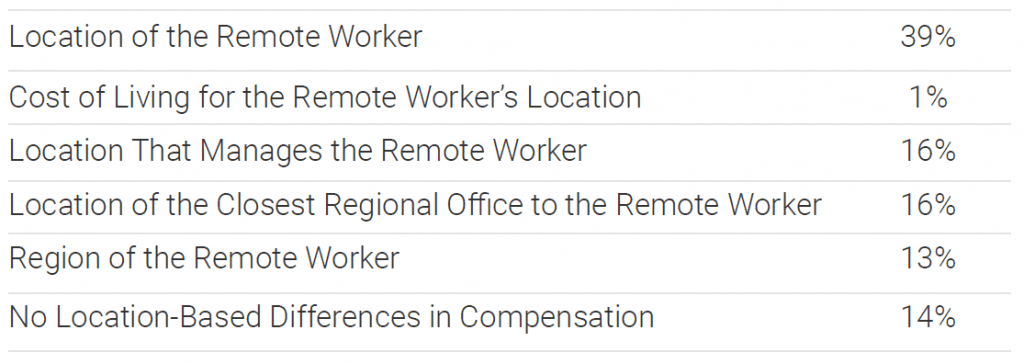The COVID-19 pandemic has suddenly and significantly increased the number of remote workers across a wide spectrum of jobs and locations. Any job that can be done remotely has been done remotely for many months. While much of the country is in some stage of reopening, many remote workers have been keeping productivity up for several months.
Many companies are opting to keep a remote workforce instead of ushering their employees back into the office during the country’s reopening as workers have maintained or increased productivity. Most noteworthy is Facebook, which plans to move a significant amount of its employees to permanent remote work. They are also considering adjusting compensation as part of this process. In announcing the move, Facebook stated that in January of 2021 they would adjust employee’s compensation based on “the cost of living in the locations where employees choose to live.”
Turns out there are many different approaches to setting pay. In this blog, we will go over a few methods. For a more detailed discussion of compensation strategies for remote workers, take a look at our Remote Worker Compensation Strategies white paper.
Cost-of-Labor Approaches
In some ways, a remote worker could be considered a company branch office with the number of employees of that branch office simply being equal to one. Therefore, using compensation methods that apply to branch offices is one option to pay remote workers.
One of the most frequently used methods is to apply geographic pay differentials when adjusting salary structures for branch offices. This takes the completed salary structure for a base location and adjusts it up or down based on the differences of overall local labor market pay rates from the base location to the second location. This cost of labor approach has several advantages, include retaining the same overall pay structure between offices, while fitting those structures to the local pay patterns.
Bands
Another method that companies often use with branch office structures is to group locations into bands, or tiers. This way, a range of individual points will fall into a single band, simplifying administration while still matching relatively closely to local labor market conditions. Of companies using geographic pay differentials, almost 80% use some sort of banding, with 5% being the most common (over 25% reported using this width) followed by 10% (over 15% reporting) according to results from ERI’s Geographic Pay Differentials in Practice survey.
Cost-of-Living Approaches
The two branch office methods (geographic pay differential and market pricing using bands) seek to match compensation costs to the local labor market pay rates. Another option, such as that suggested by Facebook, could be to use methods based on cost of living. The cost of living is primarily used in compensation planning for building relocation packages for employees moving from low-cost to high-cost areas. Some differences exist in the application to salaries. But just as it is possible to view a remote worker as a branch office of size one, it is also possible to view the remote worker as a relocated employee.
When relocating employees, one goal is to “keep the employee whole,” at least until they have had an opportunity to adjust their spending pattern to the higher cost location and cost-of-living data are compiled to support this process. This involves a detailed analysis of the employee’s spending patterns – housing situation, family size, and other individual parameters – clearly something that does not need to be done for a salary adjustment.
Implications
Some practical questions arise out of these data. Should remote workers be compensated based on cost-of-labor (labor market differential or market pricing using bands) or cost-of-living differences? Stated differently, does the company want to adjust the salary of the employee to match those with a similar job already in that labor market (cost of labor)? Or does the company want to match (or help retain) the buying power of the employee in the new or remote location (cost of living)? It is important to keep in mind that not every location is equal in terms of affordability (i.e., affordability being buying power, but for a location). Some locations tend to have above-average salaries, but relatively lower cost of living – these are considered more affordable locations. Other locations have the opposite situation.
Remote Worker Survey Results
Another way to view questions related to remote worker compensation is to look at how companies treated remote workers prior to the COVID-19 pandemic. ERI asked a question related to this topic as part of a Compensation Best Practices Survey conducted before March 2020. These were companies that had already established remote worker compensation practices. They can provide some insight into general practices already in place. Results are summarized below:

The Geographic Pay Differentials in Practice survey includes more results.
This blog’s intention was to introduce multiple ways of setting pay for remote employees. For more information on the advantages and disadvantages of each method and other aspects to consider when choosing pay levels, download our Remote Worker Compensation Strategies white paper.


